The Relationship between Tree-Ring Growths of Pinus densiflora and Climate from Three Mountains in Central Region, the Republic of Korea
Abstract
:1. Introduction
2. Materials and Methods
2.1. Study Site and Sampling
2.2. Method of Analysis
2.2.1. Tree-Ring Chronologies
2.2.2. The Tree-Ring Chronology and Climate Relationship
3. Results
3.1. Tree-Ring Chronologies
3.2. The Tree-Ring Chronology and Climate Relationship
4. Discussion
4.1. Tree-Ring Chronologies
4.2. The Tree-Ring Chronology and Climate Relationship
5. Conclusions
Author Contributions
Funding
Institutional Review Board Statement
Informed Consent Statement
Data Availability Statement
Acknowledgments
Conflicts of Interest
References
- Teskey, R.O.; Bongarten, B.C.; Cregg, B.M.; Dougherty, P.M.; Hennessey, T.C. Physiology and genetics of tree growth response to moisture and temperature stress: An examination of the characteristics of loblolly pine (Pinus taeda L.). Tree Physiol. 1987, 3, 41–61. [Google Scholar] [CrossRef]
- Noh, E.R. Studies on the Growth Range and Optimum Site Determination of the Tree Species Using Climatological Factors in Korea. J. Korean For. Soc. 1983, 62, 1–18. [Google Scholar]
- Park, S.J.; Lee, W.Y.; Lee, H.H. Organization and Identification of Wood; Hwyangmunsa: Seoul, Korea, 1987. [Google Scholar]
- Schweingruber, F.H. Tree Rings: Basics and Applications of Dendrochronology; Kluwer Academic Publishers: Dordrecht, The Netherlands, 1988. [Google Scholar]
- Fritts, H.C. Tree Rings and Climate; Academic Press: London, UK, 1976. [Google Scholar]
- Buareal, K.; Buajan, S.; Preechamart, S.; Muangsong, C.; Pumijumnong, N. A 177 Years Extended of Teak Chronology Revealing to the Climate Variability in Phrae Province, Northern of Thailand. Appl. Environ. Res. 2020, 42, 85–100. [Google Scholar] [CrossRef]
- Huang, J.-G.; Zhang, Q.-B. Tree-ring and climate for the last 680 years in Wulan areas of northeastern Qinghai-Tibetan Plateau. Clim. Chang. 2007, 80, 369–377. [Google Scholar] [CrossRef]
- Opała-Owczarek, M. Warm-season temperature reconstruction from high-elevation juniper tree rings over the past millennium in the Pamir region. Palaeogeogr. Palaeoclimatol. Palaeoecol. 2019, 532, 109–248. [Google Scholar] [CrossRef]
- Corona, C.; Guiot, J.; Edouard, J.L.; Chalié, F.; Büntgen, U.; Nola, P.; Urbinati, C. Millennium-long summer temperature variations in the European Alps as reconstructed from tree rings. Clim. Past 2010, 6, 379–400. [Google Scholar] [CrossRef] [Green Version]
- Cerrato, R.; Salvatore, M.C.; Gunnarson, B.E.; Linderholm, H.W.; Carturan, L.; Brunetti, M.; De Blasi, F.; Baroni, C. A Pinus cembra L. tree-ring record for late spring to late summer temperature in the Rhaetian Alps, Italy. Dendrochronologia 2019, 53, 22–31. [Google Scholar] [CrossRef]
- Helama, S.; Lindholm, M.; Timonen, M.; Merilaeinen, J.; Eronen, M. The Supra-long Scots Pine Tree-Ring Record for Finnish Lapland: Part 2, Interannual to Centennial Variability in Summer Temperature for 7500 Years. Holocene 2002, 12, 681–687. [Google Scholar] [CrossRef]
- Park, W.-K.; Seo, J.-W. A Dendroclimatic Analysis on Abies koreana in Cheonwang-bong Area of Mt. Chiri, Korea. Korean J. Quat. Res. 1999, 13, 25–33. [Google Scholar]
- Seo, J.-W.; Kim, Y.-J.; Choi, E.-B.; Park, J.-H.; Kim, J.-H. Investigation of Death Years and Inter-Annual Growth Reduction of Korean Firs (Abies Koreana) at Yeongsil in Mt. Halla. Korea Soc. Environ. Restor. Reveg. Technol. 2019, 22, 1–14. [Google Scholar]
- Lee, P.W. Properties and Uses of Korean Wood (I); Seoul National University Press: Seoul, Korea, 1997. [Google Scholar]
- Campelo, F.; Vieira, J.; Nabais, C. Tree-ring growth and intra-annual densityfluctuations of Pinus pinaster responses to climate: Does size matter? Trees 2013, 27, 763–772. [Google Scholar] [CrossRef] [Green Version]
- Khan, N.; Ahmed, M.; Shaukat, S.S. Climatic signal in tree-ring chronologies of cedrus deodara from chitral hindukushrange of Pakistan. Geochronometria 2013, 40, 195–207. [Google Scholar] [CrossRef] [Green Version]
- Vieira, J.; Campelo, F.; Nabais, C. Intra-annual density fluctuations of Pinuspinaster are a record of climatic changes in the western Mediterranean region. Can. J. For. Res. 2010, 40, 1567–1575. [Google Scholar] [CrossRef] [Green Version]
- Korea National Park Service. Mt. Bukhan National Park Park Resources Survey; National Park Research Institute: Wonju, Korea, 2019. [Google Scholar]
- Korea National Park Service. Mt. Seorak National Park Precision Vegetation Map; National Park Research Institute: Wonju, Korea, 2020. [Google Scholar]
- Korea National Park Service. Mt. Worak National Park Park Resources Survey; National Park Research Institute: Wonju, Korea, 2020. [Google Scholar]
- Cook, E.R. A Time Series Analysis Approach to Tree Ring Standardization; Tree-Ring Laboratory: Tucson, AZ, USA, 1985. [Google Scholar]
- Fritts, H.C. Reconstruction of Past Climatic Variabilit; Laboratory of Tree-Ring Research University of Arizona: Tucson, AZ, USA, 1976. [Google Scholar]
- Seo, J.-W. Spatiotemporal Analysis of Pinus Densiflora’s Tree-Ring Fluctuation in Mt. Worak. Master’s Thesis, Chungbuk National University, Cheongju, Korea, 1999. [Google Scholar]
- Cook, E.R.; Kairiukstis, A. Methods of Dendrochronology; Kluwer: Dordrecht, The Netherlands, 1990. [Google Scholar]
- Panayotov, M.; Bebi, P.; Trouet, V.; Yurukov, S. Climate signal in tree-ring chronologies of Pinus peuce and Pinus heldreichii from the Pirin Mountains in Bulgaria. Trees 2010, 24, 479–490. [Google Scholar] [CrossRef] [Green Version]
- Bunn, A.G.; Jansma, E.; Korpela, M.; Westfall, R.D.; Baldwin, J. Using simulations and data to evaluate mean sensitivity(ζ) as a useful statistic in dendrochronology. Dendrochronologia 2013, 31, 250–254. [Google Scholar] [CrossRef]
- Akkemik, ü.; Dağdeviren, N.; Aras, A. A preliminary reconstruction (A.D. 1635–2000) of spring precipitation using oak tree rings in the western Black Sea region of Turkey. Int. J. Biometeorol. 2005, 49, 297–302. [Google Scholar] [CrossRef]
- Speer, J.H. The Fundamentals of Tree-Ring Research; University of Arizona Press: Tucson, AZ, USA, 2010. [Google Scholar]
- Buras, A. A comment on the expressed population signal. Dendrochronologia 2017, 44, 130–132. [Google Scholar] [CrossRef]
- Baillie, M.G.L.; Pilcher, J.R. A Simple Cross-Dating Program for Tree-Ring Research. Tree-Ring Bull. 1973, 33, 7–14. [Google Scholar]
- Eckstein, D.; Bauch, J. Beitrag zur Rationalisierung Eines Dendrochronologischen Verfahrens und zur Analyse Seiner Aussagesicherheit. Forstwiss. Cent. 1969, 88, 230–250. [Google Scholar] [CrossRef]
- Rinn, F. TSAP-Win: Time Series Analysis and Presentation for Dendrochronology and Related Applications Version 4.64, User Reference; Rinntech: Heidelberg, Germany, 2011. [Google Scholar]
- Harris, I.; Osborn, T.J.; Jones, P.; Lister, D. Version 4 of the CRU TS monthly high-resolution gridded multivariate climate dataset. Sci. Data 2020, 7, 1–24. [Google Scholar] [CrossRef] [PubMed] [Green Version]
- Biondi, F.; Waikul, K. DENDROCLIM2002: A C++ Program for Statistical Calibration of Climate Signals in Tree-Ring Chronologies. Comput. Geosci. 2004, 30, 303–311. [Google Scholar] [CrossRef]
- Briffa, K.; Jones, P.D. Basic chronology statistics and assessment. In Methods of Dendrochronology: Applications in the Environmental Sciences; Cook, E., Kairiukstis, L.A., Eds.; Kluwer: Dordrecht, The Netherlands, 1990. [Google Scholar]
- Park, S.-Y.; Eom, C.-D.; Seo, J.-W. Seasonal Change of Cambium Activity of Pine Trees at Different Growth Sites. J. Korean Wood Sci. Technol. 2015, 43, 411–420. [Google Scholar] [CrossRef] [Green Version]
- Rossi, S.; Deslauriers, A.; Anfodillo, T.; Carrer, M. Age-Dependent Xylogenesis in Timberline Conifers. New Phytol. 2008, 177, 199–208. [Google Scholar] [CrossRef] [PubMed]
- Seo, J.-W.; Eckstein, D.; Jalkanen, R.; Rickebusch, S.; Schmitt, U. Estimating the Onset of Cambial Activity in Scots Pine in Northern Finland by Means of the Heat-Sum Approach. Tree Physiol. 2008, 28, 105–112. [Google Scholar] [CrossRef] [PubMed] [Green Version]
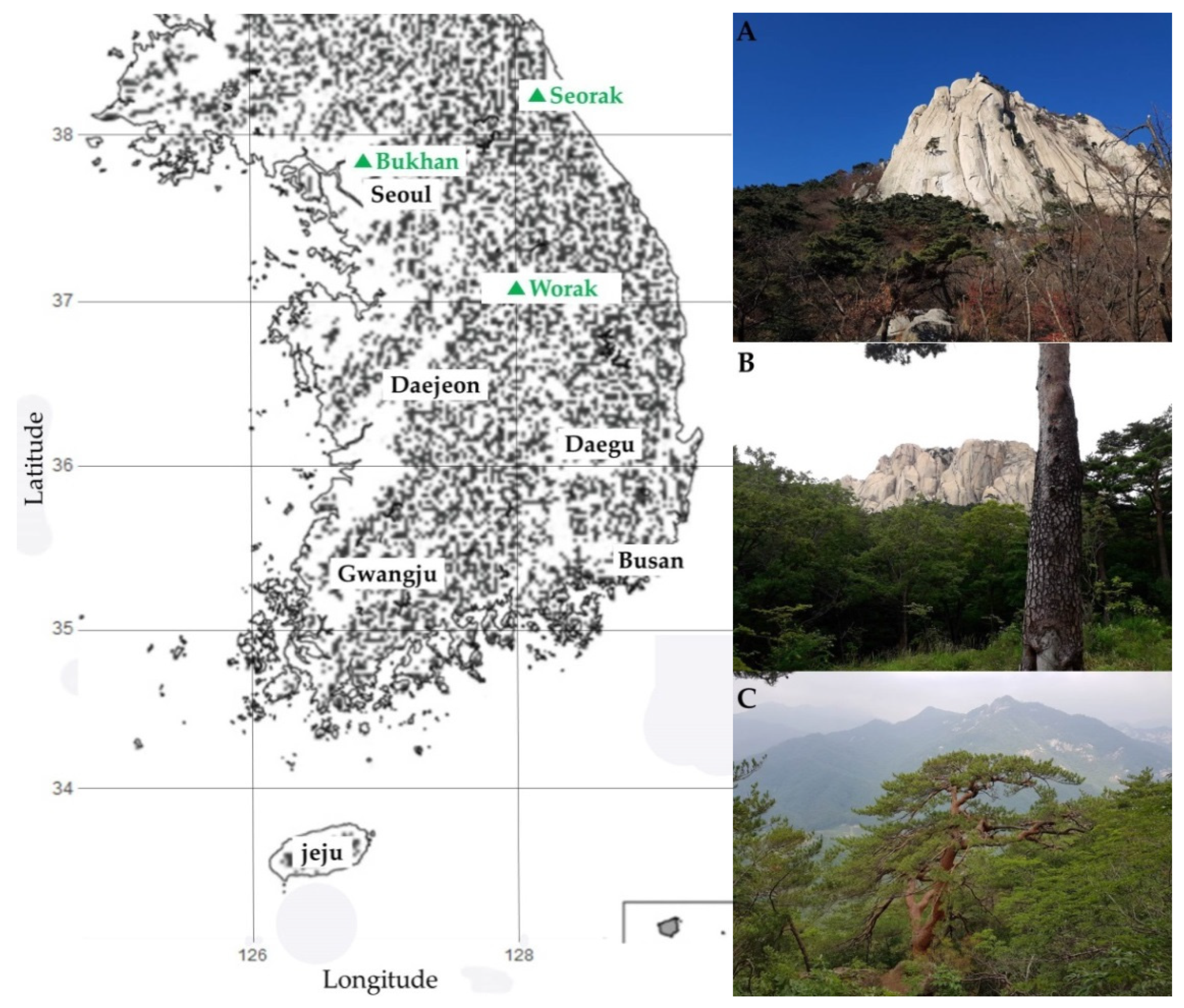
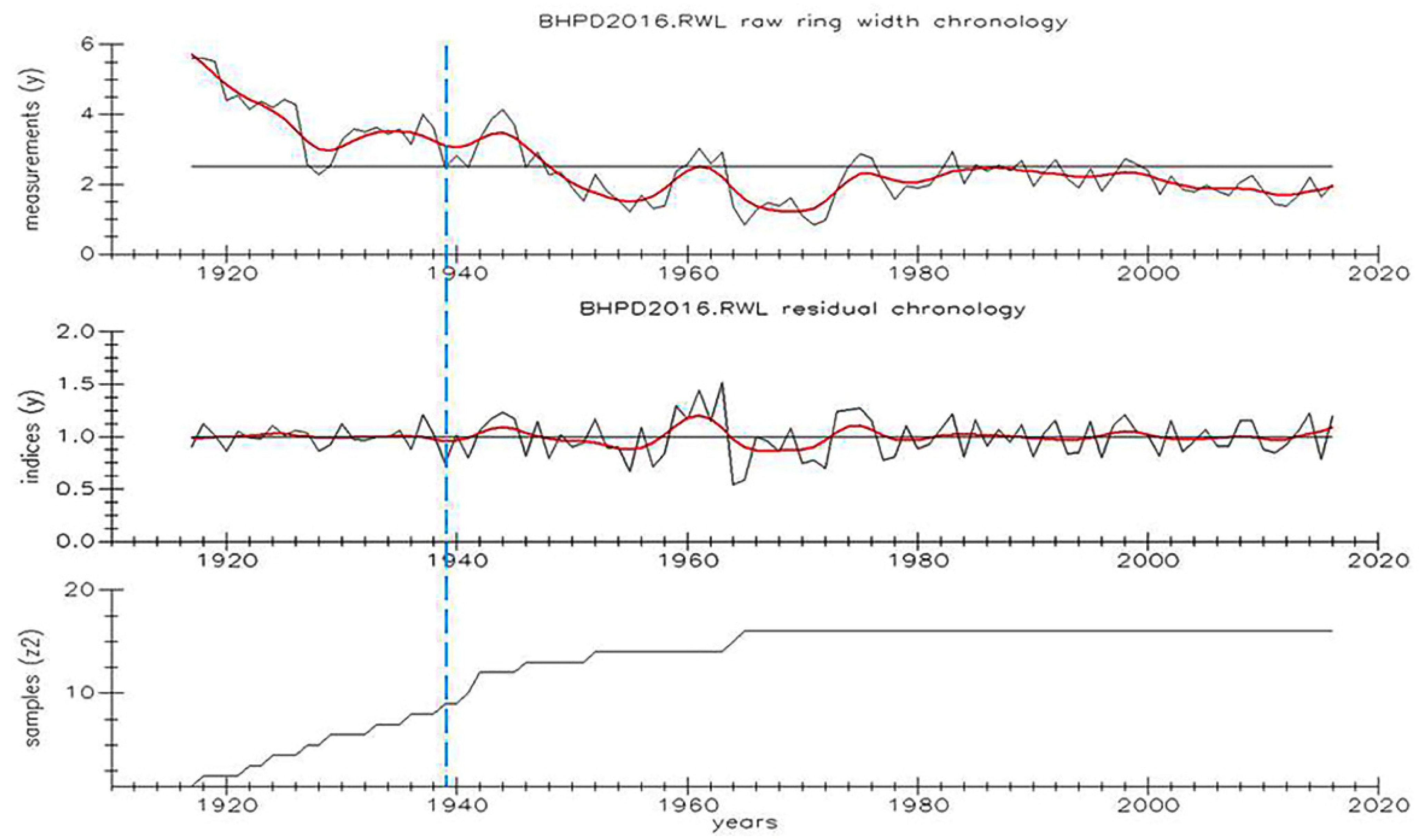
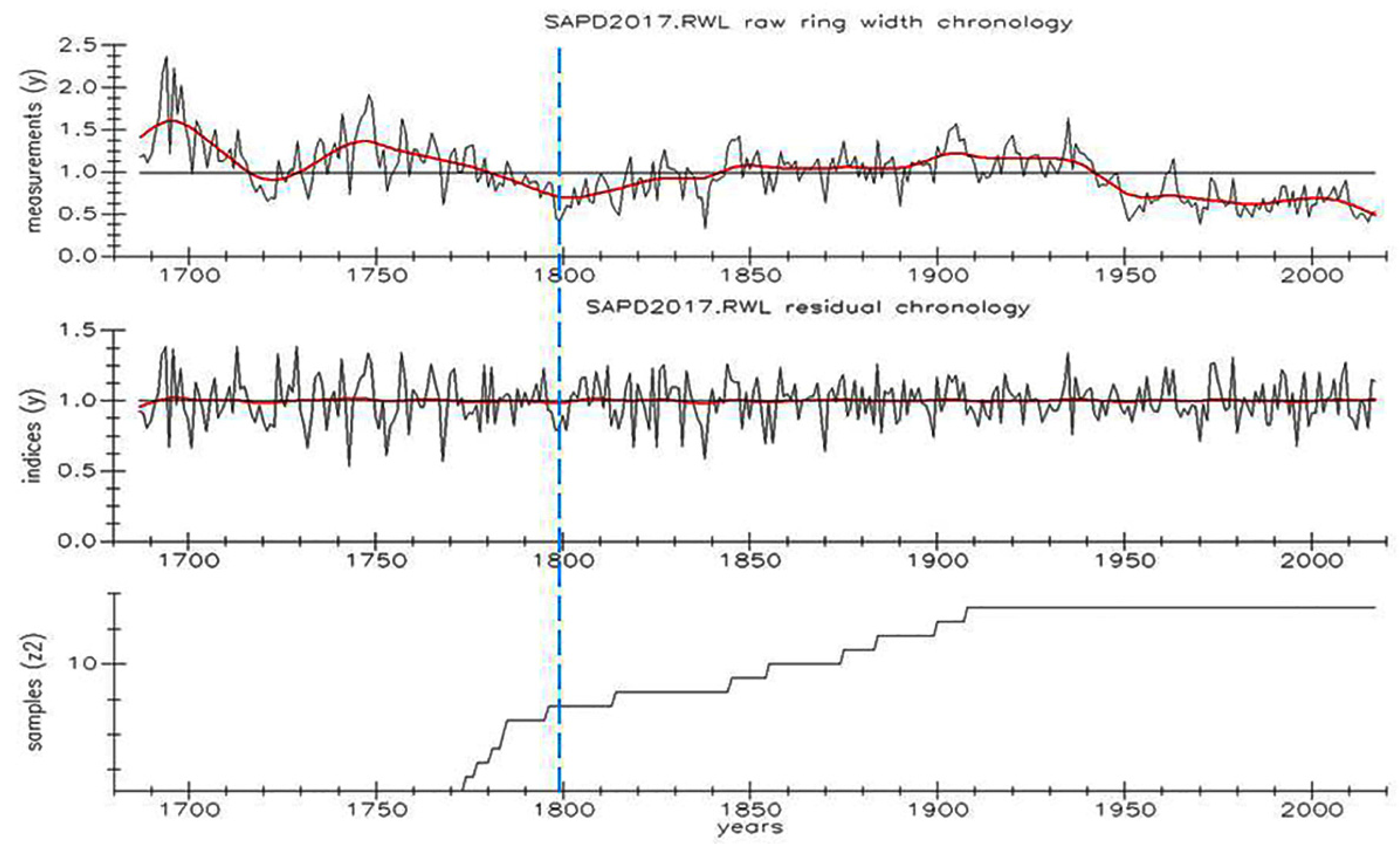
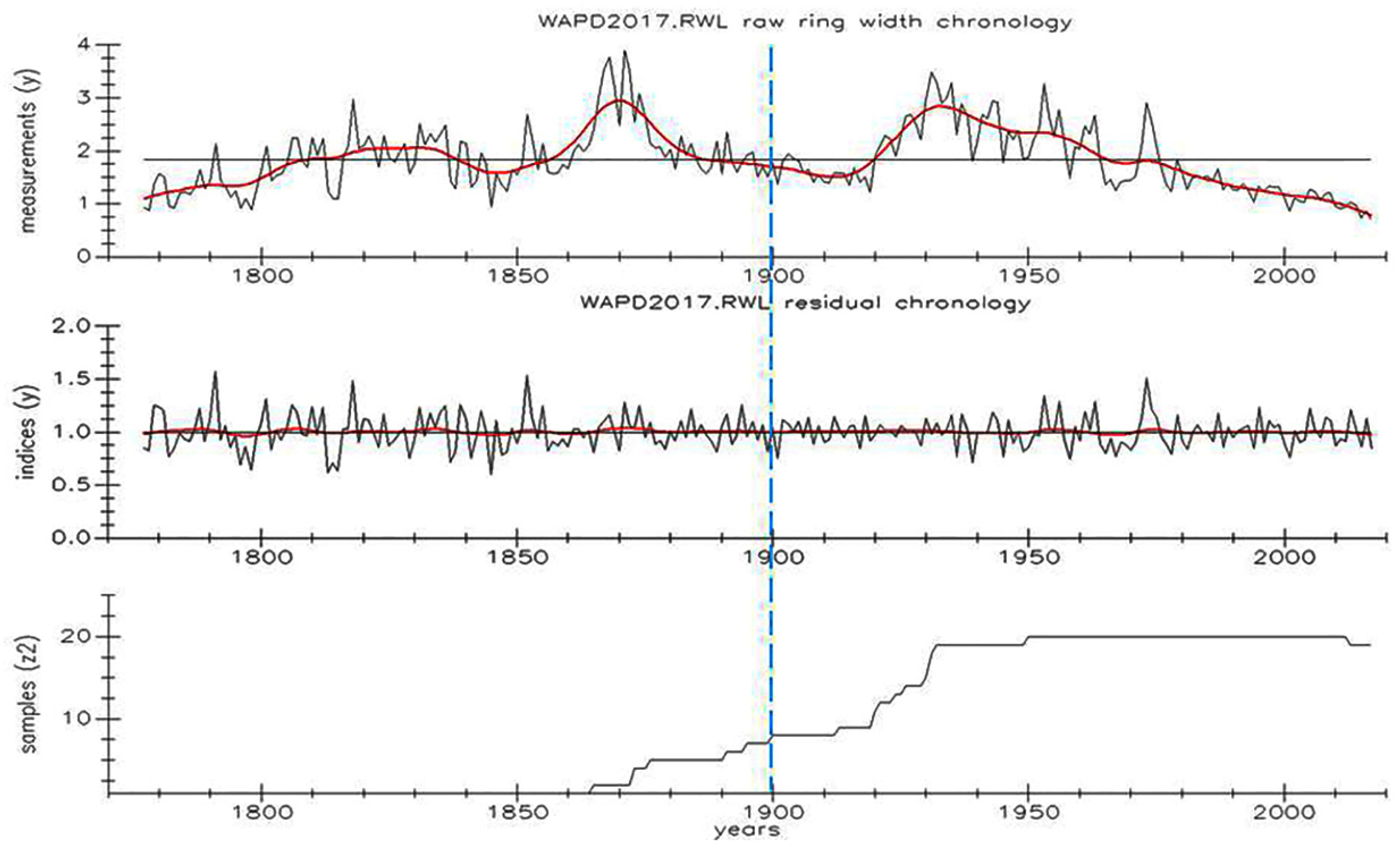
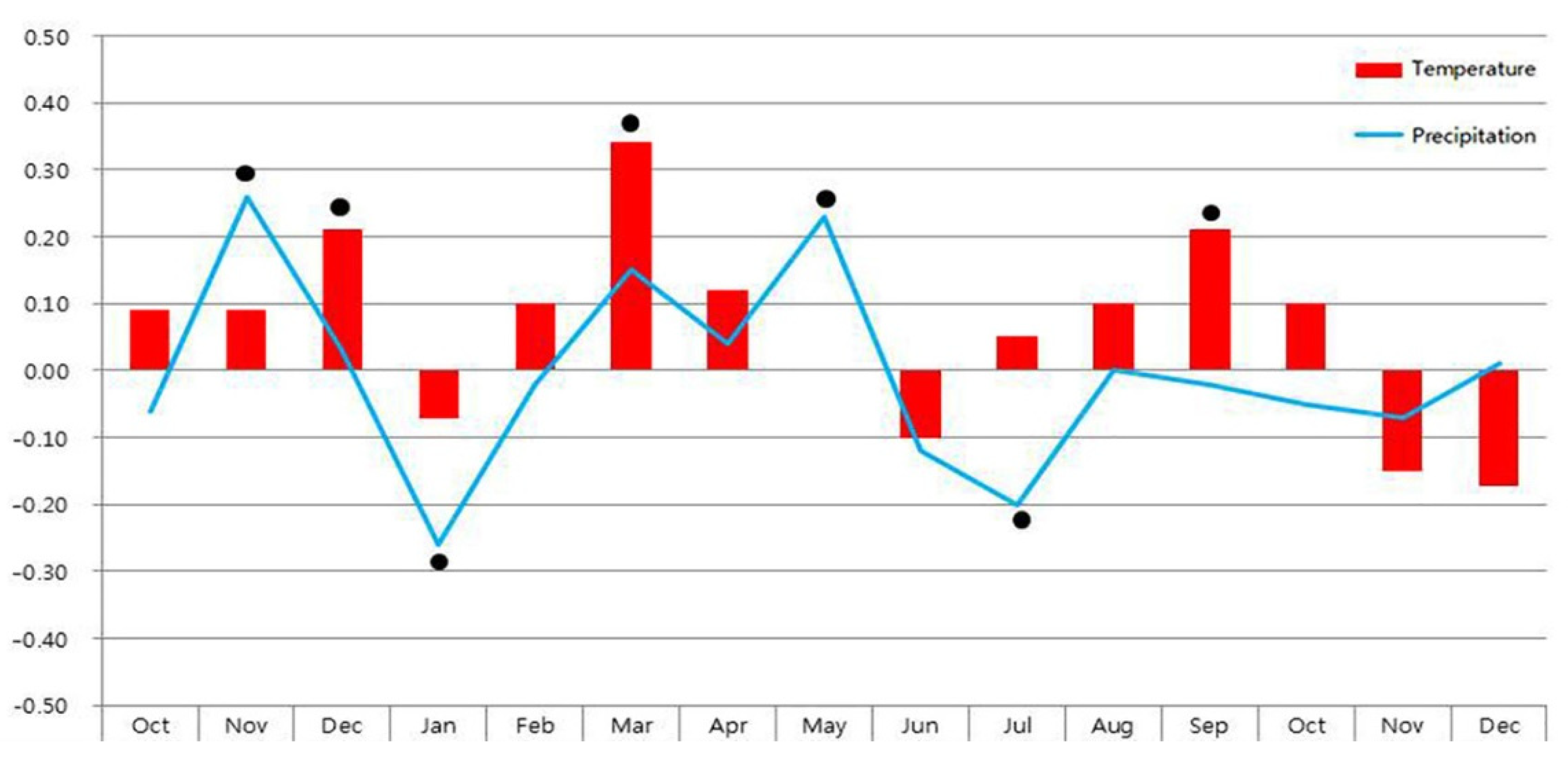
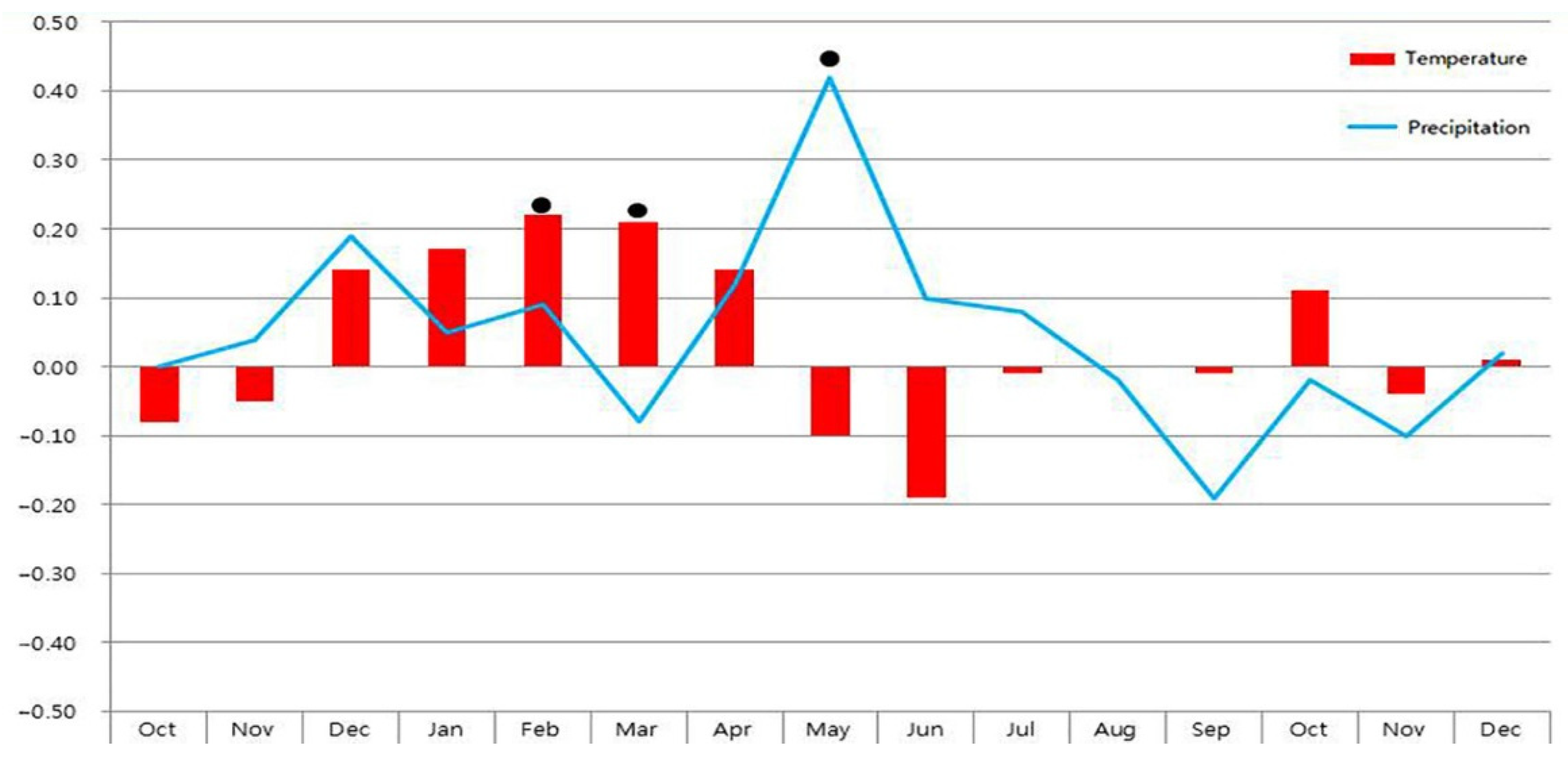

| Bukhan | Seorak | Worak | |
|---|---|---|---|
| Latitude, longitude | 37°39′ N, 126°58′ E | 38°07′ N, 128°28′ E | 36°59′ N, 128°15′ E |
| Area (km2) | 76.92 | 398.24 | 287.57 |
| Highest altitude (m a.s.l.) | 835 | 1708 | 1097 |
| Angle of slope | 10.5°–30.5° | 15.3°–31.6° | 8.9°–35.5° |
| Geology | Granite | Granite | Biotite granite |
| Exposition | E–NE | E–NE | E–NE |
| No. of cores for tree-ring analysis | 33 cores (16 trees) | 30 cores (14 trees) | 40 cores (20 trees) |
| Altitudes(m a.s.l.) | 318–720 | 383–840 | 351–940 |
| Mt. Bukhan | Mt. Seorak | Mt. Worak | |
|---|---|---|---|
| Number of samples (cores) | 16 (32) | 14 (28) | 20 (40) |
| Time span | 1917–2016 | 1687–2017 | 1777–2017 |
| Year | 100 | 331 | 241 |
| Average ring width (mm) | 2.38 | 1.15 | 2.06 |
| Mean sensitivity | 0.16 | 0.16 | 0.16 |
| RBAR | 0.367 | 0.354 | 0.398 |
| Standard deviation | 0.20 | 0.18 | 0.18 |
| First-order autocorrelation | 0.48 | 0.39 | 0.36 |
| Signal-to-noise ratio | 9.07 | 6.49 | 12.76 |
| Agreement with population chronology | 0.90 | 0.86 | 0.92 |
| Variance in 1st Eigenvector (%) | 46.24 | 52.44 | 45.44 |
| SSS of 0.85 attained (trees) | 1939 (9) | 1796 (7) | 1900 (8) |
| SSS of 0.90 attained (trees) | 1946 (13) | 1884 (12) | 1924 (13) |
Publisher’s Note: MDPI stays neutral with regard to jurisdictional claims in published maps and institutional affiliations. |
© 2021 by the authors. Licensee MDPI, Basel, Switzerland. This article is an open access article distributed under the terms and conditions of the Creative Commons Attribution (CC BY) license (https://creativecommons.org/licenses/by/4.0/).
Share and Cite
Park, C.-H.; Lee, U.-C.; Kim, S.-C.; Lee, K.-H. The Relationship between Tree-Ring Growths of Pinus densiflora and Climate from Three Mountains in Central Region, the Republic of Korea. Atmosphere 2021, 12, 878. https://doi.org/10.3390/atmos12070878
Park C-H, Lee U-C, Kim S-C, Lee K-H. The Relationship between Tree-Ring Growths of Pinus densiflora and Climate from Three Mountains in Central Region, the Republic of Korea. Atmosphere. 2021; 12(7):878. https://doi.org/10.3390/atmos12070878
Chicago/Turabian StylePark, Chang-Hyun, Ui-Cheon Lee, Soo-Chul Kim, and Kwang-Hee Lee. 2021. "The Relationship between Tree-Ring Growths of Pinus densiflora and Climate from Three Mountains in Central Region, the Republic of Korea" Atmosphere 12, no. 7: 878. https://doi.org/10.3390/atmos12070878
APA StylePark, C.-H., Lee, U.-C., Kim, S.-C., & Lee, K.-H. (2021). The Relationship between Tree-Ring Growths of Pinus densiflora and Climate from Three Mountains in Central Region, the Republic of Korea. Atmosphere, 12(7), 878. https://doi.org/10.3390/atmos12070878






